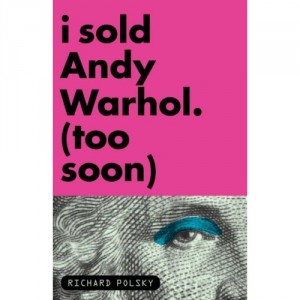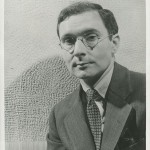Book Review: All About Art (except the art)
Mostly, Richard Polsky writes entertainingly about the art world in the American vernacular: cash.
i sold Andy Warhol. (too soon) by Richard Polsky. other press, 288 pages, $23.95.
Reviewed by Peter Walsh
 “The nature of the art business is that it’s filled with pettiness and jealousy…” complains art dealer Richard Polsky early in his new book. “That’s because anyone can become an art dealer. No one needs a license. You don’t have to pass a test certifying you know art history, have taste and ethics, and so on.”
“The nature of the art business is that it’s filled with pettiness and jealousy…” complains art dealer Richard Polsky early in his new book. “That’s because anyone can become an art dealer. No one needs a license. You don’t have to pass a test certifying you know art history, have taste and ethics, and so on.”
The universe Polsky inhabits, wild and crazy since the mid-19th century, is still the least regulated market on the entire planet, a throwback to the Gilded Age capitalist heaven of boom and bust. Your corner convenience store has to post more permits than the biggest art dealer in New York City. Art dealers, experts, auction houses, collectors, and even museums regularly engage, risk free, in practices that, on Wall Street, would land them in jail.
Polsky’s book, “i sold Andy Warhol. (too soon)” (from “other press,” whose editors must hate capital letters), belongs to the genre of tell-all art world memoir popularized by one-time Metropolitan Museum Director Thomas Hoving (who contributes a gushing blurb to the jacket). Like Hoving, Polsky offers the reader a string of juicy, insider stories chosen to give the impression they illuminate the depths of the art world.
That premise is largely false. Polsky’s turf is only a small slice of the art world: the last twenty years or so of the market for contemporary art. An artist or an art historian at Harvard or Yale or the University of London would have written an entirely different book. Dealers and curators in Old Masters and antiquities, lately hounded by international export regulations, lawsuits, even arrest and extradition, now occupy a different sphere altogether.

Author Richard Polsky
Still, Polsky’s entertaining account of his small, claustrophobic ecosystem of struggling galleries, rampaging auction houses, greedy collectors, and back-stabbing private dealers rings true in general, if not in every particular. His engaging, unpretentious style makes the book a quick read. Diversions into such serious matters as style, composition, and meaning are mercifully short, widely-spaced, and light weight. Mostly, Polsky writes in the American vernacular: cash.
This is a book about thousand dollar paintings that suddenly become hundred thousand dollar paintings, and ten thousand dollar paintings that grow up to be seventy million dollar auction records. It is a series of stunning price tags interspersed with power lunches, cocktail parties, transcontinental airplane trips, gossip, and deal making.
Polsky is charmingly candid about his role as an often hapless, mostly bit player in his increasingly high-stakes world. He lives in California, not New York. He flies Coach while his competition sits up front in First Class or zooms around in private jets. He stays in cheap New York hotels when more affluent West Coast colleagues boast their own Manhattan apartments.
The big names Polsky drops belong to persons mostly elderly, forgotten, or dead. To help close a deal, he evokes a connection to the Rose Art Museum at Brandeis, since shut down. His deals continuously teeter on the edge of collapse. His serial, gold-digging wives do everything they can to bleed him dry before dumping him.
Most bruising of all, egged on by an especially venal, short term spouse, Polsky sells his beloved Warhol painting (acquired at great effort in his previous memoir, “I Bought Andy Warhol”). Unfortunately, he chooses a moment well before the booming Warhol market peaks.
For all its surface glitz, Polksy’s business operates a lot like real estate. The only way to make really big bucks is to buy low and sell high. Failing that, you string together a living selling other people’s property for a cut of the proceeds. Along the way, you are constantly trying to convince your buyers that this Gulf Coast swamp is really “highly sought-after oceanfront acreage” or that some dimly remembered 1970s Photo Realist is about to realize “his real market potential.”
There’s another, even more crucial, step to a big score. Because saleable art, like real estate, always has an owner, you also have to convince an artist, artist’s heir, collector, or another dealer to part with the goods. Much of Polsky’s fretful, anxiety-ridden narrative is devoted to his efforts to talk someone— anyone, really, with some decent art— to fork it over so he can turn it into dollars.
“You no longer needed buyers,” Polsky says, “there are plenty to go around. You needed sellers. People who owned a significant picture knew what they had and could take their pick of which dealer to work with. Art dealing had always been about relationships. But now, not only did you have to convince property owners that you could get them a fair price, they had to believe you could get them more money than anyone else.”

Alfred Barr, Jr.: Never a curator of paintings for the Museum of Modern Art.
Polsky’s book is full of small, amusing scandals and sharp vignettes of art world egomaniacs, eccentrics, and con-artists. Many of his tales have been circulating the art world for years. Sometimes he gets things slightly wrong. The legendary founding director of the Museum of Modern Art, Alfred Barr, Jr., for example, was never that institution’s “curator of paintings.” The hard facts behind other anecdotes, such as the Hollywood mogul David Geffin’s sale of several prize works, are impossible to verify.
Despite the “tell all” attitude, though, Polsky sheds surprisingly little light on some darker corners of the art world. He briefly mentions briefly a well-publicized lawsuit against the Andy Warhol Foundation for monopoly practices and market manipulation. But he devotes no more than a few sentences to the more serious conflict-of-interest problems in an incestuous field free of rules and (for the most part) professional ethics.
“I missed the old days when dealers made at least vague attempts to enjoy the art,” Polsky laments near the end of the book. “Now that paintings had been reduced to a commodity, it became a contest to see who could make the most money. Had I known things would end up this way, I never would have gotten into the profession.”
Ever since art married capital, the art business has had much more to do with financial trends than cultural movements or creative innovation. The insane art market Polsky describes coincided with the equally loony rise of mortgage backed securities and other exotic derivatives that even the bankers who sold them didn’t understand— a speculative frenzy, now over, that briefly netted billions for many Wall Street executives and art collectors. In a brief epilogue, Polsky documents the downfall of both.
Despite the dollar signs, it had been no Golden Age, for finance or for art.
Tagged: Andy-Warhol, art dealers, art market, i sold Andy Warhold (too soon), Other Press, peter-Walsh, Richard Polsky
